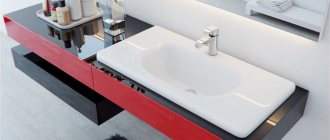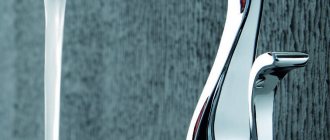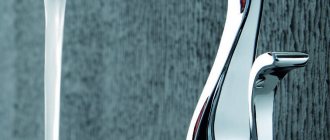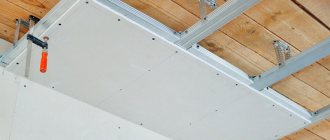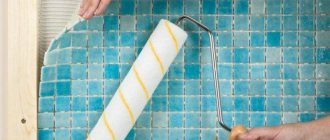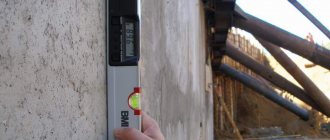One of the essential plumbing fixtures for a bathroom is a sink. Bathroom washbasins differ in shape, configuration, installation method and connection to communications. One of the most used options is to install a sink with a cabinet in the bathroom, since this model allows you to organize the storage of towels, detergents and various useful items in a convenient place.
Variety of wall-mounted washbasins
Until relatively recently, all available modifications of wall products were of the same type. They were installed using two brackets made of cast iron. Since the metal supports used to attach the sink to the wall were located in plain sight, they did not look aesthetically pleasing.
Over time, as a result of the development of the production of modern plumbing equipment, a large number of new, elegant and original models have appeared that have a hidden installation option.
There are several criteria according to which wall-mounted washbasins are classified: depending on the fasteners used for the sink, the material used to make the bowl and its shape. Pedestal sinks or products called “tulips” also fall into the category of wall-mounted models, but they have additional supporting elements that hide both the pipes and the siphon.
Furniture sets for bathrooms in which the washbasin is located in the countertop are very popular, while both a bowl and a hanging cabinet can be attached to the wall.
Products built into the countertop are easy to use, which in turn are not installed on the floor, but fixed on the wall. As a result, there is a free zone under the washbasin, which makes it convenient to use. This space makes cleaning easier.
Practical owners, wanting to rationally use the space of the bathroom, place a small-sized washing machine or a small shelf for all kinds of sanitary and household accessories under a sink of this type.
Ceramic products are the most popular. When making a choice, before fixing the washbasin to the wall, you need to remember that earthenware sinks are cheaper, but porcelain ones, which are more expensive, look more attractive.
If there is limited free space in the bathroom, it is better to choose a corner-shaped sink in the bathroom, characterized by compactness and simplicity. Unlike frontal products, they do not require a free wall, since they easily fit in a niche or in a corner where the width of the walls is 30 centimeters or more.
Corrugated and tubular siphons
It is not without reason that this design is considered the simplest of all types of siphons. Externally, it looks like a curved tube. Its fixation is carried out not with the help of threads, but with clamps. On the one hand, this allows you to avoid minor leaks, but on the other hand, it complicates installation and dismantling.
Corrugated siphon
Dropping small change into such a structure will definitely create a headache for yourself in retrieving it. At the same time, a large number of bends and the plasticity of the material make it possible to install it in almost any hard-to-reach place.
- The bottle siphon can be placed in a place with a certain height from the sink to the floor. With regard to a corrugated appliance, the position of the sink makes virtually no difference. Made from corrugated plastic, the siphon bends easily, and its water seal can be placed even away from the sink, thereby saving space.
- On the other hand, a bendable tube clogs faster. After all, the corrugated surface of the tube is not only on the outside, but also on the inside. If such a siphon becomes clogged, you will have to dismantle all its elements. In this sense, manufacturers offer their customers combined models, which at the same time partially consist of corrugated tubes and a bottle siphon.
- A tubular siphon is best installed under the bathtub, however, it is also suitable for sinks. It has a strong, rigid pipe that prevents rapid clogging, but is much more difficult to install. This sink siphon with overflow will require a certain position of the sink in relation to the floor. Often this design simply takes up a lot of space, and if there is a need to install a small sink, then this model should be abandoned immediately.
The process of installing a bathroom sink
The choice of method for attaching the sink to the wall in the bathroom depends on the model of plumbing fixture being installed. For example, the job of installing a single piece of china is different from installing a countertop-mounted unit, although both options involve fixing to the wall.
Currently, the most common way to mount a sink is on brackets, which are studs or screws screwed into the walls. To ensure proper installation of plumbing fixtures, you should use detailed instructions.
The process of attaching a bathroom sink to the wall consists of the following steps:
- Preparatory activities.
- Making markings on the wall.
- Creating holes.
- Fixing fasteners to the wall.
- Installing a washbasin bowl.
Preparatory activities
Preparing for the process of hanging a sink in the bathroom involves purchasing plumbing fixtures, a faucet, a drain kit and checking the reliability of the wall. First of all, you need to make sure that the wall of the room can support the selected washbasin model.
In apartments, during renovations, they often carry out redevelopment or build a false wall. As a result, instead of a load-bearing wall, there may be drywall under the ceramic tiles. If the base is not strong enough before fixing the sink to the wall, it must be partially disassembled and the mountings installed. For example, you can use wooden blocks or metal guides.
In order not to be distracted from work when installing a sink in the bathroom, you need to prepare in advance a set of certain tools, including:
- drill or hammer drill;
- metal ruler or tape measure;
- level;
- marker;
- an adjustable wrench or a set of open-end wrenches.
In addition, before attaching the sink to the wall in the bathroom, you need to purchase a sealant, and in some cases you will need a special adhesive composition.
Marking the wall
The quality of fastening the sink to the wall in the bathroom depends on the correct marking. If the hole is not made accurately, then the cladding may need to be redone. It will not be difficult to purchase a new plastic panel, but ceramic tiles, especially when they are collectible, are much more expensive, and besides, they may not be found on sale.
Therefore, before attaching the sink to the wall, it is necessary to determine the exact installation location, usually a height of 85 - 90 centimeters. You will also need to measure the gap between the holes prepared for fasteners. Plumbing manufacturers indicate the necessary information regarding these parameters in the instructions included with the new product.
When starting to figure out how to fix a sink in a bathroom, you should take the dimensions from the bowl, find the required values on the diagram, and then transfer them to the wall. Places where holes should be made are marked with a marker.
In some situations it is easier to perform a trial installation of the device. Typically, this method is chosen when it is necessary to install models with countertops, hanging cabinets or tulip sinks. You should make sure that communications are connected in close proximity to the place where you plan to mount the sink on the wall.
Design
There are floor-mounted and hanging versions of the lockers. The first ones do not need to be fastened; the legs organically fit antique wooden models. The latter are more compact, do not interfere with the feet, look modern, and the structures are removed from floor dampness.
Combination console.
Floor-standing installation, drop-in sink.
The washbasin is embedded into the countertop or placed on top. The last case is easier to implement. An insert without a countertop minimizes the size of the cabinet, but takes up useful space; the shelves have to be lowered below the bottom of the sink. When placing the washbasin on top of the panel, make do with a cutout for the drain pipe.
Shelves with open shelves are more reliable - there is nothing to break, they are well ventilated, and it’s easier to do it yourself. Disadvantages: basket with towels, folded accessories will be splashed. It is convenient to store the necessary little things in drawers; you will have to tinker to achieve stable movement without jamming or distortion. A compromise approach is shelves covered with doors.
Drilling holes for mounting
At this stage, problems with creating a washbasin mount mainly arise when drilling walls lined with ceramic tiles. Despite the fact that such work seems simple, it requires appropriate experience, otherwise the wall finish will be damaged.
The fact is that before attaching the sink in the bathroom, when drilling tiles and the base for it from concrete or brick, you need to use different drills and use certain operating modes. Not all masters do this work well. To ensure that the drill does not slip and enters the tile smoothly, it is necessary to use a core.
It must be placed at the point where the hole is created and carefully hit with a hammer several times. Next, you can change the drill to a hammer drill and continue drilling holes in the wall. The diameter of the Pobedit drill is 12 millimeters. The minimum depth required to install the brackets is 5 centimeters, but the exact dimensions can be found in the instructions.
The prepared holes for fastening the sink to the wall are cleaned with a vacuum cleaner or any available tools.
Detailed installation instructions
We start with preparing the tools.
To work you will need:
- gas key;
- screwdriver;
- wrenches;
- drill with a drill equipped with a pobedit tip;
- hammer;
- construction level;
- marker or pencil.
In addition, you need to prepare plumbing sealant, sealant such as Fum tape and fasteners. On sale you can find special sets of fastenings for sinks. If you purchase such a kit from a trusted manufacturer, this will be the best option.
Some sink models are designed to be mounted on the wall using brackets. In this case, installation begins with their installation
After the tools and materials are prepared, turn off the water, both hot and cold. You can start working.
Marking the location for attaching the sink
Let's start with the markings. The first thing to mark on the wall is the central horizontal line. It will become the upper limit along which the edge of the plumbing equipment will be set. Using a level, check the horizontal position. Use short vertical lines to mark the width of the bowl.
Next, we measure the thickness of the side walls of the sink and set this value down from the central horizontal line.
We connect both marks with a line that will show the mounting height of the brackets. After that, take the shell and turn it over. Then we fix the brackets on the side walls. After this, we apply the bowl to the upper horizontal mark and press it against the wall.
At the same time, we make sure that all previously outlined lines coincide. Insert a marker into the hole and mark the places for installing fasteners.
Installing fastenings for brackets
We take a drill with a Pobedit drill bit and prepare holes for fasteners in the designated places. Their depth should slightly exceed the length of the dowels, and their diameter should be slightly smaller than the cross-section of the bushings. You can put a little glue inside the holes to make the insert plugs stick better.
Using a hammer, hammer the dowels into the holes. Then we take the fasteners and screw them one by one into the plastic base.
Installing brackets for the sink
We install brackets on the prepared fasteners, which are supports for the bowl. We place the sink on them and, holding it with our hand, mark with a marker the places where the fasteners will be installed to secure the device to the wall.
We remove the bowl and prepare holes for fastenings. We hammer the liners into them and screw in the fasteners.
After the brackets are installed on the wall, you can hang the sink on them, observing the dimensions and strictly following the manufacturer’s recommendations
Before installation, apply sealant to the edge of the bowl to prevent water from leaking into the gap between the wall and the sink. As an option, you can use a special plastic strip, which will provide maximum protection from water. We glue it with silicone sealant. We put the sink in place, but do not fix it completely yet.
Install and connect the mixer
You need to know that the faucet can be mounted on the installation platform before the sink is put in place, or after that. Everyone does what is convenient for him. In any case, you need to remember that special materials will be needed to install the mixer.
Usually the manufacturer completes their products with them. If this is not the case, you will need to purchase additional studs, nuts, washers and gaskets.
Before installing the mixer, it is advisable to carefully read the manufacturer's instructions and strictly follow its recommendations. Typically, such instructions describe in detail the installation process, taking into account all the features of a particular model.
First, the mixer must be assembled into a single unit. In this case, tabs and seals must be used. Before assembly, an O-ring is usually placed on the spout.
The nuts must be removed from the studs, and then the mixer put back in place. First, a sealing ring is placed under the device and connecting hoses are pulled into the hole on the mounting plate.
The equipment is fixed to the sink using a clamping nut. This is done very carefully so as not to overtighten the nut, otherwise the shell may crack.
When purchasing a mixer, you should carefully check its contents. It is desirable that it contains all the elements necessary for installation.
If the pipeline couplings and the mixer inlet axes do not fit together, the connection is made using special eccentric adapters. They have different thread diameters on opposite ends. The clamping nut is first tightened by hand, then with a wrench half a turn. Most often this is quite enough.
Once the faucet is secured in place, you can connect it to the water supply. Most often, flexible hoses are used for these purposes. We attach them to the pipes. We supply hot water to the left hose, cold water to the right.
We first tighten the nuts by hand, and then tighten them with an adjustable wrench. To seal the connection, be sure to use Fum tape or a similar material. Rewinding is performed along the thread.
An important nuance: the length of flexible hoses. It should not be too large, otherwise it will sag unsightly. Also, it cannot be too small, otherwise the hose will be stretched, which will cause its premature failure. In addition, the hoses must lie flat, without twists or kinks.
A sink faucet selected according to style and size is installed on the prepared seat and carefully secured with a clamping nut.
After completing the work, it is necessary to check the quality of the connections. This must be done after the siphon is connected, since you will have to supply water to the mixer.
During the inspection, the possible presence of water at the flexible connections and near the mixer is carefully monitored. If this is the case, then the nuts need to be slightly tightened with a wrench.
Detailed instructions for installing the mixer are described in this article.
We connect the siphon to the sewer
You can find different models of siphons on sale; there may be some nuances when installing each of them, so you should carefully study the installation instructions from the manufacturer. Let's consider the simplest option with a universal corrugated siphon.
First, we disassemble the siphon and check it for the presence of gaskets, the strength of the threads and the absence of debris inside the assembly. During the installation process, it is advisable to moderately lubricate the threads and gaskets with sealant, so the protection against leakage will be even more reliable.
We press the siphon with a special thick gasket against the drain with one hand. This must be done so that the gasket, without displacements or gaps, fits tightly to the drain along its entire perimeter. With your other hand, insert the mesh, screw and gasket into the drain hole.
Carefully tighten the screw, then tighten it. We fix the corrugation. To do this, insert it into the drain socket of the siphon and carefully tighten it with a wing nut.
When assembling the siphon, be sure to moderately lubricate all connections and seals with sealant to avoid leaks and the need to constantly tighten parts
We connect the siphon to the sewer pipeline. To do this, we insert a special rubber seal inside the pipe and install the corrugation bell into it. An important point: the corrugated pipe must lie flat, without kinks or twists. This completes the installation of the siphon.
You can conduct a test run of water and check for leaks. If liquid is leaking somewhere, the defect should be corrected immediately.
The sink is fixed in the same way without brackets. The installation process differs in that it is fixed directly to the wall, so during the marking process, the installation locations of the fasteners are marked, holes are drilled and dowels are driven in. Then the sink is applied to the wall and fixed in this place with special fasteners.
“Tulips” and “half-tulips” are fixed in the same way. Their distinctive feature is the presence of a pedestal on which the bowl is placed. It is important to correctly determine the installation height of such a sink, because it must exactly match the height of the pedestal.
After the bowl is installed on the sink mount, a pedestal base is installed under it.
Fixing fasteners to the wall
Anchor bolts are used as washbasin holders, which are inserted perpendicular to the wall surface. To ensure that they fit tightly and do not wobble, you need to insert plastic plugs or dowel-type elements inside the holes.
Often, fasteners for a washbasin to the wall are included with the purchased plumbing fixtures, so you don’t need to select anything. Metal rods are carefully screwed into the holes so that the ends of the required length are located outside.
In some cases, problems arise with securing anchors due to the presence of a crack or seam under the tiles in the base. Before fixing the sink, to correct the situation, you can concrete the gap and try to make a hole. There is another, simpler method: you need to pour epoxy glue into the cavity and immediately insert a bolt into the hole for better fixation.
Care requirements
Of course, a lot depends on the material from which the overhead device is made, what its porosity is, whether the coating absorbs dirt strongly and whether it is prone to streaking.
Countertop sinks made of earthenware or porcelain are easy to clean. In order to clean such products, you need to have a soft cloth and any liquid detergent on hand, preferably without an abrasive component.
Acrylic overhead bowls do not like hard brushes with coarse bristles. To clean acrylic, use gel-based detergents that do not contain alcohol.
Caring for a countertop sink will depend on the type of material.
Glass sinks that are overhead must be handled with extreme care, and not primarily because they can break, but because any drops and splashes after drying leave untidy marks and stains on the glass surface. That is why it is recommended to wipe them dry.
Wooden devices can withstand everything except rough processing and abrasives. But if scratches appear on the surface and the top protective layer is damaged, the product may become moldy and even begin to rot.
Do not wash natural marble countertop sinks with acid-containing solutions or caustic powder. Damage to the stone increases its porosity, which means that the resulting dirt and stains will be almost impossible to remove.
Installing a sink bowl
There is nothing complicated about how to hang a sink on the wall at the final stage. The washbasin must be strung on anchor bolts and pressed tightly against the wall. Then tighten the nuts with spacers at the ends of the pins that remain free. When they are tightened, the washbasin is pressed and glued.
The advantage of these manipulations is that they provide a more durable attachment for the washbasin to the wall, and the disadvantage is that there will be problems with replacing plumbing fixtures in the future. If it becomes necessary to remove the bowl for a more convenient installation of a siphon or mixer, this will not be possible.
Next, after completing the installation of the washbasin, you need to connect the mixer and drain with a water seal. The sequence of actions after the installation under the sink is completed may vary. Often, the drain and faucet are installed first, and then the installation of the washbasin is done. All that remains is to connect the hoses.
System health check
Before you start using the washbasin, you need to check the quality of the connections and how firmly the bowl is installed. To do this, check the quality of all fasteners again. After this, open the hot and cold water tap and check the tightness of the water hoses. If there are water leaks, then the connections must be tightened, and when this does not help, unscrew the hose and rewind the FUM tape.
To check the tightness of the siphon, it is recommended to fill the sink with water by closing the drain hole . Then drain all the water - if there are no leaks in the siphon or hoses, then you can start using the sink.
When draining the water, check the tightness of the connections.
Do not over-tighten the connections, as you may damage the gaskets or strip the threads.
Mixer installation
As practice shows, it is easiest to install the faucet before attaching the sink to the wall. The washbasin is placed in a convenient position and the mixer is fixed on the shelf of the bowl in the hole provided for this purpose.
Before installing the mixing device, you need to place a protective and shock-absorbing gasket. It should be located exactly under the base of the mixer.
The installation process consists of the following steps:
- The mixer is installed in place.
- Install the mounting bracket.
- Correct the location of the mixer.
- Perform final tightening of fasteners.
The installation process does not depend on the design features of the mixer - valve and lever products are installed in the same way. Connections to the water supply system are also made in the same way. Flexible hoses from the mixer are connected to the outlet points of the hot water and hot water pipes and the nuts are tightened.
The joints are sealed if necessary. When the faucet is installed correctly, the cold water tap is located on the right, and the hot water tap on the left. At the end of installation, testing is performed. It is carried out after connecting the drain and with the aerator removed.
Tips that will not be superfluous
You may find the installation process too simple. But it is not so.
Errors or negligence during this work can lead to deterioration in the appearance of the sink or damage to the countertop if water constantly penetrates into the space between it and the sink.
If you are not sure that you are able to cope with the task, invite a specialist. But then you won't be able to save money. Think about what is more important to you.
To completely dispel your doubts, we suggest you watch a video in which the installation process is performed by a professional.
Drain connection
Before attaching the sink to the wall, you need to connect the drain - a water seal made of metal or plastic with corrugation or pipes. One of the best options for this device is the bottle model, which is easy to install and can be cleaned without much effort if a blockage occurs.
To connect the siphon to the outlet pipe, use union nuts and cone gaskets, following the instructions. They act in a similar way when assembling the element connecting the structure with the overflow.
First, a drain is assembled from individual elements and installed with an overflow. Then they install a corrugated water seal and connect the drainage device to the sewerage system. An important point is to check the drain for leaks. The operation of the mixer is also checked.
Close the drain valve with a stopper, fill the washbasin and watch as the water leaves through the overflow.
Then the plug is removed and checked to see if the siphon is leaking. If there are no leaks, after installing the faucet and drain, work on the fasteners for the washbasin. The process of installing plumbing largely depends on the model of bathroom equipment. You can do this work yourself. The process is also simplified by the fact that you do not need to purchase a special tool; before attaching the sink to the wall in the bathroom, a standard home kit will be enough.
What is overflow
An overflow is an additional tube that is removed from the sink and connected to part of the siphon or its pipe. It prevents water from overflowing over the edge of the sink. The water, having reached the second hole in the sink, located close to its edge, begins to calmly flow down the overflow into the sewer. Thus, flooding of an apartment with such a design is unlikely. Accordingly, recently the demand for such a model is significantly higher than for siphons without overflow.

